Gold (XAU) has been a coveted asset for centuries, prized for its economic stability and diverse applications, from electronics to gourmet cuisines. As the market has continued to grow, gold remains as a significant trading asset.
This article delves into the intricacies of gold trading, from its fundamental value propositions and historical context to modern-day trading strategies and insights, providing a comprehensive guide for those keen on exploring the golden opportunities gold has to offer.
Key Points
- Gold’s value is historically stable, making it a sought-after asset for hedging against economic uncertainties and currency devaluation.
- Gold can be traded physically or digitally, with modern instruments like ETFs and CFDs offering flexibility without the need to own the actual metal.
- Trading gold offers benefits like high liquidity, portfolio diversification, and protection against inflation, while various trading strategies can be used to maximise returns.
What is Gold (XAU) in Financial Trading?
Gold (XAU), often touted as a “safe haven” asset, has historically maintained its value in times of market uncertainties. This lustrous precious yellow metal that has captured human’s fascination for centuries and till today, is still sought after for its role as a hedge against economic uncertainties.
What Makes Gold Valuable?
Gold’s intrinsic value is not merely a product of modern economics but has deep-seated historical underpinnings. As far back as 1500 BC, the ancient Egyptians, recognising its worth and stability, instituted gold as the official medium of exchange for trade [1]. This not only solidified its role in ancient commerce but also set a precedent for its utilisation in subsequent civilizations. The Egyptians even introduced the Shekel, a coin weighing 11.3 grams, which later became a standard measurement in the Middle East [2].
Transitioning to more recent history, the US monetary system prominently adopted the gold standard, a system where the value of currency was directly tied to a specific amount of gold. This system remained in place until the 1970s, underscoring the metal’s lasting influence in shaping monetary policies and structures. The persistent global trust in gold, demonstrated by its use across various cultures and periods, emphasises its unmatched importance and reflects the deep confidence societies, both ancient and contemporary, place in its stability and value.
Gold Price Over the Years
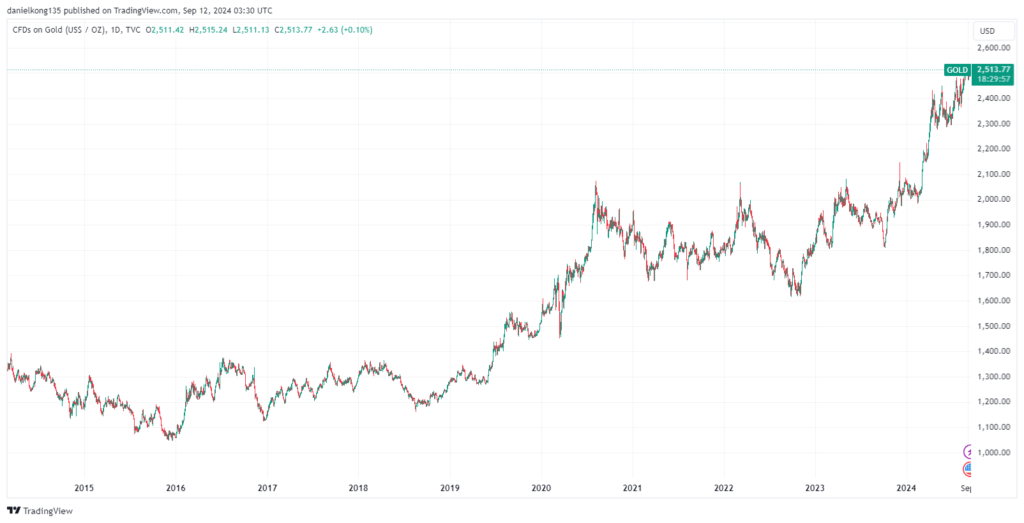
Following the 2008 Global Financial Crisis and eurozone debt issues, gold prices consistently surpassed $1,000, peaking at a record $2,075 during the 2020 Covid-19 outbreak. Despite periodic fluctuations, like dropping to $1,046 in December 2015 due to the dollar’s strength, geopolitical tensions and central bank demands have since buoyed prices. External events, such as the Russia and Ukraine conflict in 2021, kept the precious metal above $1,800, reaching $2,070 by March 2022.
As of 11 September October 2024, gold sits at approximately $2,512 per ounce [3]
What Makes Gold a Good Trading Instrument?
Gold has continued to demonstrate its durability and worth throughout history. This precious metal, known for its unique properties and beauty, has transitioned from ancient vaults to modern-day investments. As we continue to explore gold’s inherent qualities, we will better understand its significance in today’s trading environment.
Investment Opportunity
Gold, traditionally viewed as a stable asset, shines especially bright during economic uncertainties. Its intrinsic value combined with global recognition positions it as a sturdy shield against inflation and currency devaluation. When the financial landscape becomes volatile, seasoned investors gravitate towards gold, valuing its consistent preservation of value.
Economical Role
Tracing back through history, gold has consistently played a pivotal role in shaping the economies of numerous civilizations. Beyond just a trade medium, it has been a definitive measure of affluence and an integral foundation for monetary frameworks. In the modern world, its relevance is further emphasised by the substantial gold reserves maintained by central banks, underscoring its enduring importance in global economic structures.
Rare Material
One of the captivating traits of gold is its rarity. This inherent scarcity underpins its lofty value. Unlike renewable resources or commodities that see annual production or harvest, gold’s quantity on our planet is limited. Its limited availability, coupled with the intricacies of mining and extraction, solidifies its position as a sought-after material.
Durable and Non-Corrosive
Among gold’s many attributes, its durability and resistance to corrosion stand out. Unlike most metals, gold remains impervious to degradation. This enduring quality ensures gold’s lasting allure, making it not just a dependable currency but also a centrepiece in jewellery and historical artefacts.
Why Trade Gold
Gold has long been valued for its stability, particularly during economic downturns. Its lasting worth distinguishes it from currencies that can devalue due to government decisions and inflation. Historically, gold has offered a sense of security and is often regarded as a safe asset during times of economic uncertainty.
Incorporating gold into a trading portfolio provides diversification, since it responds differently to market changes than stocks or bonds, thereby balancing potential risks and rewards. Moreover, gold has high liquidity, making it easier to buy and sell. One can also access Gold using various investment products such as Exchange Traded Funds (ETFs), Contracts for Differences (CFDs), options, and futures. Trading gold can also act as a safeguard against geopolitical uncertainties and currency shifts, adding to its appeal for traders and investors.
What is Gold Trading
Gold trading involves buying and selling gold to profit from its price fluctuations. There are various methods for gold trading, such as gold Exchange-Traded Funds (ETFs) and Contracts For Differences (CFDs). With CFDs, traders can benefit from the gold market’s rising and falling price changes without owning the actual gold. The value of a CFD is determined by the price difference between the start and end of the trade, allowing traders to trade gold and seize trading opportunities on both rising (long) and falling (short) gold prices.
Gold Market Participants
The gold market boasts a varied mix of participants, from individual retail traders and investors to major institutional investors. Central banks assume a crucial role, maintaining gold reserves as a component of their monetary policy. Gold mining companies affect the market’s supply, with their operations directly influencing gold prices. Gold traders introduce liquidity into the market, swiftly responding to international events and economic trends, and are pivotal in price determination.
Every participant in the gold market brings a unique set of objectives and strategies, together shaping a dynamic trading environment.
Forms of Gold
Gold can be traded in various forms, each with its unique advantages. Physical gold, like bars and coins, represents the most traditional method and is favoured by those seeking tangible assets.
Gold futures are contracts promising future delivery or cash settlement. Exchange-traded funds (ETFs) and derivatives, such as CFDs, offer a more accessible avenue for individuals aiming to trade gold without possessing the physical commodity. Gold certificates are another form, serving as proof of gold ownership where the holder doesn’t physically possess the gold but has a claim to a specified amount, making transactions and storage more convenient.
Each form of gold serves different trading goals and risk preferences, granting traders an abundance of opportunities to navigate the gold markets.
Gold Trading Instruments
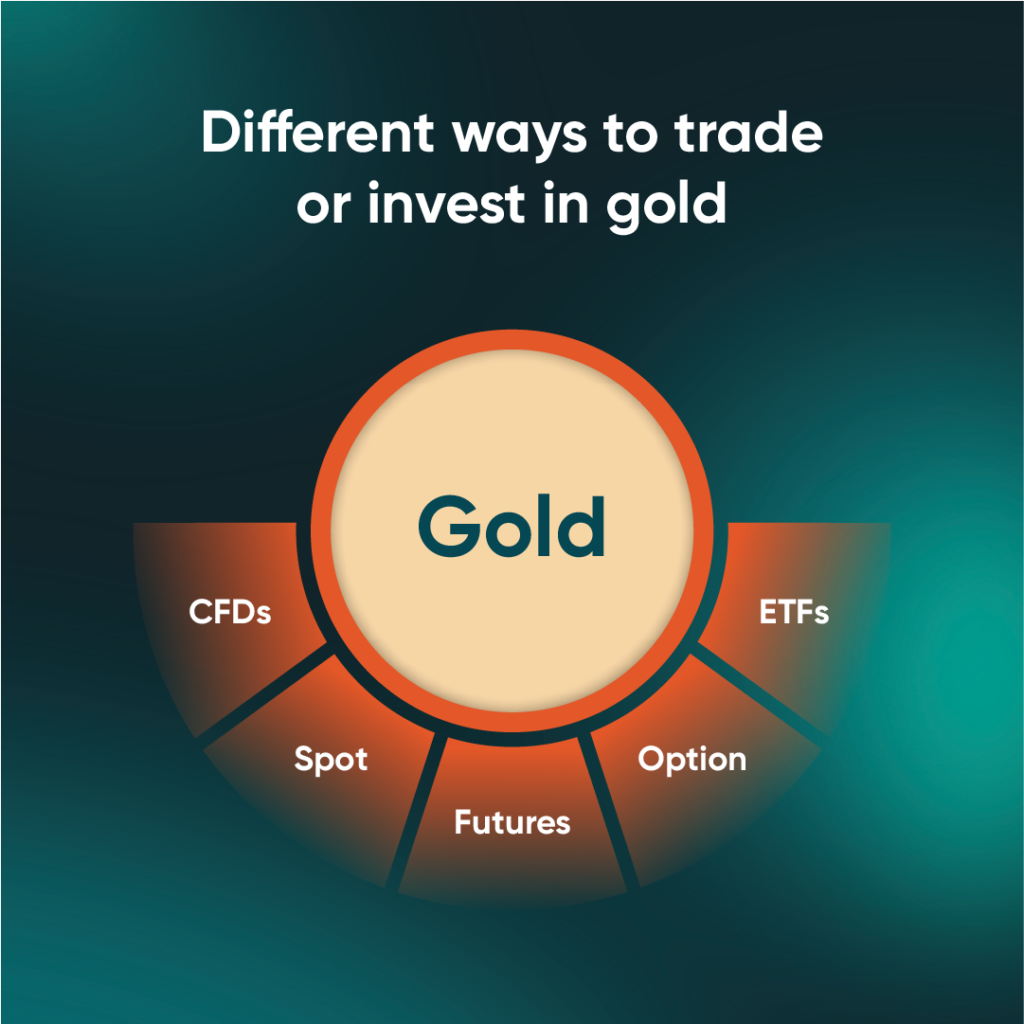
There are various gold trading instruments tailored to suit different trading objectives and risk profiles. This array of instruments provides traders with multiple avenues to access the gold market. From immediate transactions in the spot markets to the structured approach of futures and options, and the convenience of ETFs, each instrument presents unique opportunities in gold trading.
CFD
Trading gold using CFDs has steadily grown in popularity over time. CFDs allow traders to seize trading opportunities on the price movements of gold without actually owning the underlying asset. XAU CFDs, which represent gold paired with major currencies, provide an accessible pathway for traders to tap into the gold market.
Gold CFD trading offers flexibility, allowing for both short and long position capabilities. Moreover, the ability to trade CFDs on gold with leverage not only enhances the potential for higher returns but also introduces the risk of greater losses. It is important for traders to be well-informed about the leveraged nature of CFD trading before making any trades.
Spot Markets
Spot markets are where gold is bought and sold for immediate delivery. It represents the current market price of gold and offers a direct and straightforward way for traders to invest. Transactions in the spot market are typically settled within two business days, providing quick and efficient trading opportunities for those looking to respond rapidly to market movements.
Futures Contracts
Futures contracts allow traders to buy or sell gold at a predetermined price on a set date in the future. These contracts offer a way to hedge against potential price fluctuations, making them popular among those looking for some predictability in their investments. They enable participants to lock in prices today for future delivery, providing both security and speculation opportunities. Additionally, futures contracts can be traded on established exchanges, offering transparency, liquidity, and a standardised framework for traders.
Options
Options grant traders the right, but not the obligation, to buy or sell gold at a specific price within a designated time frame. They offer flexibility, allowing traders to seize trading opportunities on price movements without necessarily owning the underlying asset. With options, traders can hedge against adverse price shifts or capitalise on potential market upswings, all while controlling their level of risk.
ETFs
Gold Exchange-Traded Funds (ETFs) provide an easier avenue for investors to gain exposure to the gold market without holding the physical metal. ETFs track the price of a basket of gold related products and are traded on stock exchanges, combining the methods of stock trading with the benefits of gold investment. They’re ideal for those seeking lower capital output and higher liquidity as compared to holding actual gold to invest in gold’s value dynamics.
Analysing Gold (XAU)
The realm of gold (XAU) analysis, including gold fundamental analysis and gold technical analysis, is vast. These methodologies aim to explore and interpret price movements by considering both intrinsic and extrinsic factors that may influence gold prices.
Fundamental Analysis
When analysing the fundamentals of gold, several factors influence its overall value. Investors and traders will consider the broader economic, political, and social events that could affect gold price. Elements such as inflation rates, interest rates, political instability, and global economic conditions are all pivotal. Here are a few key factors that plays a role in gold fundamental analysis:
- Central Bank Actions: Central banks play a significant role in the gold market. If they choose to sell a large portion of their gold reserves, it can lead to an increased supply, which can potentially drive gold prices down.
- US Dollar Value: Gold prices often move inversely to the U.S. dollar. When the dollar is strong, gold prices may decrease, and vice versa.
- Interest Rates: Interest rates can influence gold’s value. Typically, when interest rates rise, gold prices may decline as investors seek assets with a yield.
- Gold Prices and Geopolitical Events: Major geopolitical events can instil fear in investors, leading them to turn to gold, potentially driving its price up.
- Jewellery and Industrial Demand: The demand for gold in jewellery manufacturing and industrial applications can also impact its price. An increase in demand in these sectors can push gold prices higher.
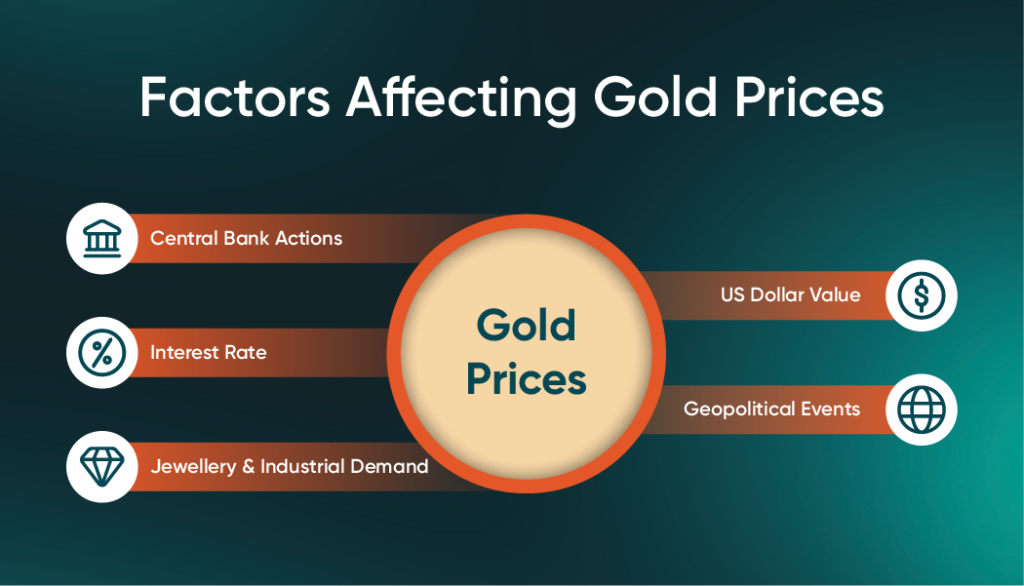
Technical Analysis
Gold technical analysis on the other hand takes a different approach where the focus is predominantly on the price and volume data of the gold price charts. This method requires traders and investors to observe and analyse how the gold past price movements. The analysis is often done through a wide variety of tools and indicators such as moving averages, trendlines, and chart patterns to make future price predictions.
For example, if gold’s price has been steadily rising above its 50-day moving average, a technical analyst might see this as a bullish (or upward) trend. Similarly, certain patterns like the “head and shoulders” or “double top” can suggest potential price reversals. In summary, fundamental analysis seeks to comprehend the underlying factors influencing the price of gold, whereas technical analysis endeavours to forecast its future price trajectory based on historical trends and patterns.
Calculating Gold Pips
In the world of forex trading, “Pips” stand for “Percentage in Point” and are the tiniest units that signify a change in currency value. When trading gold, pips gain a unique definition.
Here’s how it works: The price movement of gold is often traced to the fourth decimal place, so a change of 1 pip corresponds to a 0.0001 shift in the gold price. If your forex broker uses a $0.01 gold pip, then for every pip movement in gold’s price, traders will either gain or lose $0.01. This means 100 pips are equivalent to a $1 movement.
To determine the number of gold pips in a trade, you’d calculate the difference between your entry and exit prices. For instance, buying gold at $1,800.25 and selling at $1,802.25 results in a 20-pip difference. To compute the value from gold pips, simply multiply the number of pips by the pip value. If you earn 20 pips on a trade with a gold pip value of $0.01, you’d have a profit of $0.20.
Gold Trading Strategies
Gold trading offers diverse opportunities, employing various strategies to maximise returns while managing risks.
Long Term Investment
A long-term investment strategy in gold involves buying and holding onto the precious metal for an extended period, often years or even decades. Investors choose this method based on gold’s historical record as a store of value and its ability to act as a hedge against inflation and economic downturns. By investing long-term, investors and traders can mitigate the impact of short-term market volatility, relying on gold’s intrinsic value to remain consistent over a long period of time.
Day Trading
Day trading gold involves entering and exiting trades within the same trading day. Those who employ this strategy for gold aim to capitalise on short-term price movements rather than long-term trends. It requires traders to have an understanding of market analysis and swift decision-making. Day traders typically utilise technical indicators and real-time news updates to predict minute-by-minute price shifts, making frequent trades throughout the day.
Swing Trading [4]
Swing trading is a strategy that focuses on capturing price “swings” or movements over a short to medium time frame, which can range from a few days to a few weeks. Swing traders look for moments when gold prices might be poised for a significant move, either upward or downward. They utilise both technical and fundamental analysis to identify potential price breakouts or reversals. Once a potential swing is identified, traders enter the market and hold their position until their target price or exit plan is met.
Seasonal Pattern
Gold prices, like many other assets, can exhibit seasonal patterns or tendencies based on various annual events, demand cycles, or historical trends. For instance, gold might see increased demand during certain festivals, holidays, or times of the year when jewellery purchases are prevalent. Seasonal pattern traders study these recurring timeframes and base their trades on the predictable demand and supply changes, aiming to make returns from these periodic price fluctuations.
Trend Trading [5]
Trend trading, as the name suggests, involves identifying and following a clear trend in gold prices, whether it’s upward (bullish) or downward (bearish). Traders using this strategy rely on technical analysis tools, such as moving averages, to determine the direction and strength of the prevailing trend. Once a trend is identified, traders seek to enter the market in the direction of the trend and stay in the trade until there are indications that the trend might be reversing or losing momentum.
Gold Trading Tips
Here are some gold trading tips to help you get started:
Target Previous Highs and Lows
Targeting the previous highs and lows in gold trading offers insights into potential future price movements, as these historical markers often act as psychological barriers for traders. The XAU/USD pair typically operates within certain bounds, allowing traders to use these highs and lows as reference points for buy and sell signals. For an upward gold trend, a prior high can be viewed as a potential selling point, and the opposite is true for a downward trend. While these historical points provide a gauge and opportunities, their extended duration might not be optimal for day traders seeking quick gains.
Trade during New York Hours
Gold trading during New York hours presents opportunities as the city is primarily the significant hub for gold trading. This period often sees heightened liquidity and considerable price movements, further amplified by key financial data and announcements that can influence gold prices. Although gold trades around the clock, the New York hours are when liquidity peaks, making it an ideal window for many traders. However, those looking to scalp may lean towards after-hours for the uptick in volatility, even though it brings an added risk to XAU/USD positions.
Use Symmetrical Triangle for Analysis
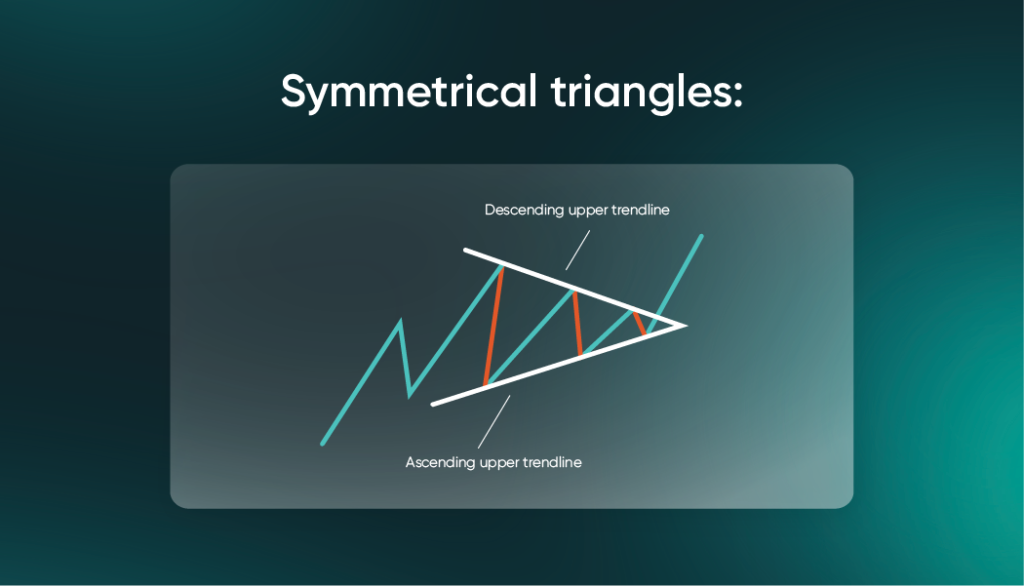
The symmetrical triangle is a technical analysis pattern formed by converging trend lines, one ascending and one descending, and is commonly used by traders to forecast potential price breakouts in gold. As the price contracts within this triangle, it indicates an impending breakout, though its precise direction remains uncertain. This pattern symbolises a phase of market indecision where buyers and sellers contend for control. By observing this formation and combining it with other technical tools, such as the Relative Strength Index (RSI), traders can better anticipate breakout directions in the XAU/USD pair.
Monitor Central Bank’s Gold Purchases
Central banks maintain gold reserves both for its intrinsic link to currency and as a hedge against financial risks. Notably, when they foresee currency instabilities, they may acquire more gold, suggesting potential price shifts. For example, in 2022, the Russian central bank decided to purchase gold from commercial banks at a predetermined price as a move to support the Russian Rouble [6]. Such actions often indicate an expectation of major currency depreciation and can result in a short-term rise in gold prices, presenting opportunities for traders, especially in the XAU/USD pair.
Target MA Crossovers
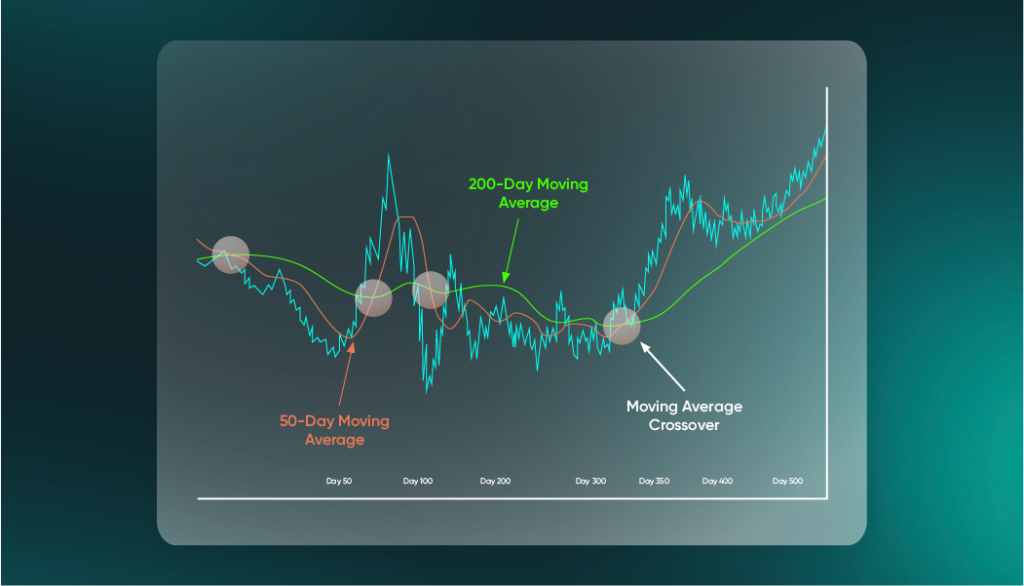
Moving average (MA) crossovers are another fundamental tool used in technical analysis. These crossovers occur when a short-term MA, such as the 50-day MA, intersects with a longer-term MA, like the 200-day MA. An upward cross of the short-term over the long-term MA typically indicates a bullish trend and a potential buying opportunity, while the opposite suggests a bearish trend and a potential selling point. By targeting these crossover points, traders can get a sense of the gold market’s momentum and make informed decisions on when to enter or exit a trade.
How to Trade Gold (XAU)
Gold, represented as XAU in trading lingo, can be traded against various currencies, providing a dynamic way to benefit from its price fluctuations. Two prominent pairs that traders often consider are XAUUSD (gold against the US dollar) and XAUSGD (gold against the Singapore dollar). These currency pairs showcase how much of the respective currency is required to purchase one ounce of gold.
Now, whether you’re interested in trading these pairs or investing in gold directly, you’ll first need to set up a trading broker account. This account will allow traders to access the gold market and execute their trades. There are usually fees involved when initiating a trade with a broker. In the context of gold trading, one key fee to understand is the gold spread. It refers to the difference between the bid and ask price, and understanding its value can help traders gauge potential returns from their trades.
Partnering with the right broker is important. Different brokers offer varying fees, trading tools and resources which can impact your trading experience. Select a broker that not only provides a user-friendly platform and reliable customer support but also offers educational resources to help you better understand trading concepts.
Here’s how you can sign up for a live trading account with Vantage:
1. Open a live account with Vantage
2. Deposit funds to your newly created account
3. Analyse the gold markets and determine which product you wish to trade
Conclusion
Gold (XAU) is a historically significant precious metal known for its intrinsic value, stability, and various practical applications such as in electronics and medicine. Its value has been recognised since ancient civilisations and over the years, the price of gold has been influenced by various factors including central bank actions, geopolitical events, and the U.S. dollar’s value.
In trading, gold offers a wide range of strategies from long-term investments to day trading and arbitrage. Potential traders should understand key concepts like gold pips, employ analytical methods such as fundamental and technical analysis, and partner with reputable brokers to navigate the gold market efficiently.
FAQS
What are the benefits of owning gold?
Owning gold offers a myriad of benefits, ranging from its role as a reliable investment, especially during economic uncertainties, to its historic significance in shaping global economies and serving as a foundation for monetary systems.
The metal’s rarity, coupled with challenges in mining and extraction, amplifies its value, making it a sought-after asset. Additionally, its durability and resistance to corrosion, unlike many metals, underscore its lasting allure, ensuring its continued appeal in both the financial world and as a treasured element in jewellery and artefacts.
What is the gold standard?
The gold standard is a monetary system where a country’s currency or paper money has a value directly linked to gold. Under this system, governments guarantee that currency can be exchanged for a specific amount of gold, ensuring the currency’s stability. This practice was widely adopted by many countries but has since been largely abandoned in favour of fiat currency systems.
How can I invest in gold?
There are several ways to engage in gold trading, including buying and selling spot gold, gold futures, gold options, CFDs or investing in gold stocks and ETFs. To execute a CFD trade on Vantage, you’ll require a live trading account. This enables you to participate in the gold market and seize trading opportunities on the price movements of gold.
Do countries hold stores of gold?
Yes, many countries maintain reserves of gold as a part of their national assets. These gold reserves act as a safeguard against economic uncertainties and can bolster a country’s financial credibility on the global stage. Central banks and governments store this gold, and its quantity can influence monetary policies and international economic relations.
Is gold a good investment for diversification?
Yes, gold is often considered a good investment for diversification purposes. Investing in gold can provide a hedge against economic uncertainties, currency fluctuations, and inflation. By including gold in a diverse portfolio, investors can potentially reduce overall risk, as gold often moves inversely to traditional assets like stocks and bonds.
What are the potential risks of investing in gold?
There are a few potential risks that come with investing in gold:
1. The price of gold may not always align with the inflation rate, even though many investors purchase gold as a hedge against inflation.
2. Gold’s value can be influenced by political events.
3. Owning gold physically can incur storage expenses.
CFDs and Spreadbets are complex instruments and come with a high risk of losing money rapidly due to leverage. 72.5% of retail investor accounts lose money when trading CFDs and Spreadbets with this provider. You should consider whether you understand how CFDs and Spreadbets work and whether you can afford to take the high risk of losing your money.
The information has been prepared by Vantage UK as of 10th September 2024 and is subject to change thereafter. The information is provided for educational purposes only and doesn’t take into account your personal objectives, financial circumstances, or needs. It does not constitute investment advice. We encourage you to seek independent advice if necessary. The information has not been prepared in accordance with legal requirements designed to promote the independence of investment research. No representation or warranty is given as to the accuracy or completeness of any information contained within. This material may contain historical or past performance figures and should not be relied on. Furthermore estimates, forward-looking statements, and forecasts cannot be guaranteed. The information on this site and the products and services offered are not intended for distribution to any person in any country or jurisdiction where such distribution or use would be contrary to local law or regulation.
Vantage is a trading name of Vantage Global Prime LLP which is authorised and regulated by the Financial Conduct Authority. FRN: 590299
Reference
- “Gold: The Most Precious of Metals – FocusEconomics” https://www.focus-economics.com/blog/gold-the-most-precious-of-metals/ Accessed 2 Oct 2023
- “Gold: The Most Precious of Metals – FocusEconomics” https://www.focus-economics.com/blog/gold-the-most-precious-of-metals/ Accessed 2 Oct 2023
- “Gold Prices – 100 Year Historical Chart – Macrotrends” https://www.macrotrends.net/1333/historical-gold-prices-100-year-chart Accessed 12 September 2024
- “Swing Trading: Definition and the Pros and Cons for Investors – Investopedia” https://www.investopedia.com/terms/s/swingtrading.asp Accessed 9 Oct 2023
- “Trend Trading: Definition and How Strategy Aims For Profit – Investopedia” https://www.investopedia.com/terms/t/trendtrading.asp Accessed 9 Oct 2023
- “Russia’s central bank says it will stop buying gold at a fixed price – Reuters” https://www.reuters.com/business/russias-central-bank-says-it-will-stop-buying-gold-fixed-price-2022-04-07/ Accessed 9 Oct 2023
The information has been prepared as of the date published and is subject to change thereafter. The information is provided for educational purposes only and doesn't take into account your personal objectives, financial circumstances, or needs. It does not constitute investment advice. We encourage you to seek independent advice if necessary. The information has not been prepared in accordance with legal requirements designed to promote the independence of investment research. No representation or warranty is given as to the accuracy or completeness of any information contained within. This material may contain historical or past performance figures and should not be relied on. Furthermore estimates, forward-looking statements, and forecasts cannot be guaranteed. The information on this site and the products and services offered are not intended for distribution to any person in any country or jurisdiction where such distribution or use would be contrary to local law or regulation.


